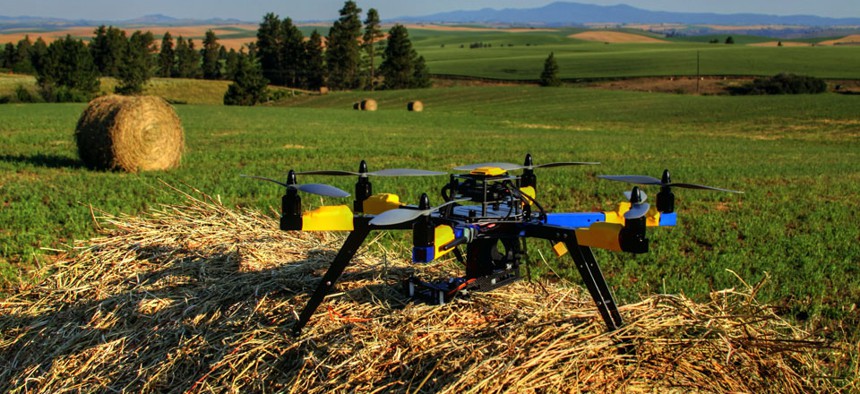Will New Drone Regulations Stifle Innovation?

A multi-rotor hexacopter, an unmanned aircraft that farmer Robert Blair purchased to monitor his farm in Kendrick, Idaho. Courtesy of Robert Blair/AP
Regulators have a lot to consider when allowing commercial drone use—namely, how not to screw up the market potential.
Cory Booker, the gregarious junior senator from New Jersey, likes drones. He thinks they offer a host of economic growth possibilities to agriculture, infrastructure, and basic commerce. I didn't know he was into drones until he brought it up at a hearing last week on the "Internet of Things," a two-hour extravaganza examining the implications of computerizing and Web-enabling everything from refrigerators to insulin pumps. There were jokes about FitBits and supercookies and sour milk.
This was a hearing about the Internet, after all, and so drones didn't come up until Booker mentioned them, well in to the hearing's second hour. Clearly it's something he's been thinking about. "I watch our government go slow in promulgating rules" on drones, he said. Meanwhile, "innovation has spread to other countries."
As if on cue, the Federal Aviation Administration released proposed regulations on small unmanned aerial vehicles over the weekend that lay out a framework for small drone use that include commercial endeavors. The proposal will take a few years to be finalized. Right now, commercial use for drones is banned, although the FAA has issued some two dozen exemptions, allowing them for agricultural surveying, oil-drum inspections, and filmmaking. Amazon and Google are waiting anxiously for the rules so they can use the drones for deliveries. FAA's proposed rule would not allow that for now. It dictates that small drones must only fly over people involved in their use, not bystanders. But even those limited beginnings signal the start of a new era. Once a rule structure is in place, it's a safe bet the market will follow its lead.
Booker, like a lot of drone enthusiasts, is frustrated with the slow pace of ruling. "A lot of innovation is not happening in the United States," he grumbled. For example, he noted that drones are used in the United Kingdom to repair power line poles, saving the utilities money and liability from the risks of sending a human being up there.
Lance Donny, CEO of the agriculture data company OnFarm, said farming can make a "wonderful case for drones." Among other things, farmers can use them to monitor crop growth and fine-tune pesticide use, saving money and chemicals.
Drones may be the hottest issue in aviation these days. The Senate Commerce Committee is planning an FAA reauthorization bill later this year, and a staffer told me that one of the most exciting parts of the job will be integrating UAVs into the legal code. Certainly, drones get peoples' attention in a way that long-distance airline slots at Reagan National Airport do not. Lawmakers from both parties see the FAA as dragging its feet on commercial use of drones, but the regulators arguably have a plausible excuse—this stuff is hard. How do you draw up a rule that will anticipate the use of drones five years from now, let alone 10?
One thing is clear, however. If the subject starts cropping up in non-aviation conversations like last week's hearing on new Internet innovations, it will soon need to be resolved. And that resolution, if Booker is correct about the potential explosion of commercial uses, will probably not be the last word.
NEXT STORY: FAA Proposes New Rules for Commercial Drones


